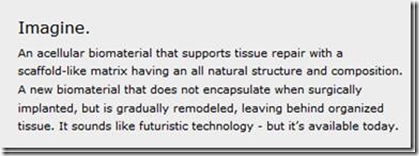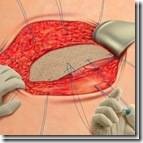Regenerative Medicine and how it works – Interview with Cook Biotech (Medical)
This week I had the opportunity to talk with Mark Bleyer, President of Cook Biotech and Mike Hiles, Ph.D., VP of Research and Lead Research
Scientist at Cook Biotech. We spoke about regenerative medicine, recent innovations and the surgical products Cook Biotech has been working on. Both Mark and Mike expressed that Cook’s main goal in this industry is to improve quality of life for patients and create safer, less invasive applications that treat everyday problems.
If you are a regular reader of the blog, recently I have posted several articles about Regenerative Medicine, most recently regarding the TED conference held in Long Beach, California. If you have not seen the video, it is well worth watching. One of the patients mentioned in the video was actually a “case study” using a Cook Medical product. The woman in the case study was a patient who had diabetes and was told she needed to have her foot amputated due to a diabetic-related open wound on her foot that would not heal. By treating the wound with the regenerative, biologic repair from Cook Medical, her foot was spared and no amputation was necessary.
Another note about the patient was that she also suffered from cancer. Because she was treated for her wound with Cook’s biologic repair, she was afforded a “better quality of life” without having to undergo surgery for an amputation - on top of her cancer treatment.
Regenerative Medicine – Material and Cell Based Regeneration of the Human Body
Cook Medical is one of the largest, private medical device companies in the world. Being private certainly has its advantages, and that includes the flexibility to venture forward in science and innovation – which is important now more than ever in the quest to focus on the needs of patients.
Although advances in science and regenerative medicine continue to be very exciting, it is important to Cook Medical to raise awareness around the practical applications and everyday treatments that can benefit patients now.
On with the interview.
Mark Bleyer was able to answer questions about Cook Biotech’s place in the market and where they are taking their products, while Mike Hiles added additional input on the science behind regenerative medicine.
I have previously done several interviews with Cook Medical with different divisions, but I asked the two to tell me a bit more about Cook Biotech.
Mark told me that currently more than one million patients have been treated with technologies from Cook Biotech that began in 1997 with the Wound Healing products developed in collaboration with Purdue University. These patients have been treated with Cook’s biologic repair for conditions such as chronic wounds (in the military as an example), hernia repair and pelvic disorders. Using regenerative medicine technology is a breakthrough technique for the replacement and repair of damaged human tissue. In other words, this is where medical treatments start to grow back living tissue that has been damaged or lost.
The revolutionary material is derived from the small intestine of pigs and communicates with the body, signaling surrounding tissue to grow across the scaffold, which in turn allows the body to naturally restore itself. Historically, surgical procedures have involved using plastic or synthetic repairs. These types of non-natural devices, however, often do not mesh well with the human body and thus are always a foreign product. Cook’s product enables the natural reproduction of human tissues and the biologic repair becomes a natural, functioning part of the body.
I asked Mark and Mike why the product was derived from pigs and why the specifically the small intestine. They shared that the cells in the intestines grow back faster than many other body parts, and when you stop and think about the digestive process, the intestines are rapidly processing the food we eat and thus have an accelerated rate of repair over other cells. The cells from the small intestine also communicate rapidly with the body to produce regeneration of cells. A good analogy is to think of the construction industry, and the scaffolds that go up to allow a project to be built. The biologic mesh is the lattice or groundwork that is supplied to allow the body to go to work.
 “SIS Composition
“SIS Composition
As a natural biomaterial, SIS is primarily protein with secondary amounts of carbohydrates and lipids.
SIS is obtained from the intestine using a process that retains the natural composition of matrix molecules such as collagen (Types I, III, VI), glycosaminoglycans, (hyaluronic acid, chondroitin sulfate A and B, heparin, and heparan sulfate), proteoglycans, and glycoproteins (fibronectin), which are known to have important roles in host tissue repair and remodeling.”
A video from the website offers a bit more of an explanation.
The Cook Biotech products are known in the medical community as Biodesign and have many applications.
Biodesign products are used for procedures such as:
- Hernia repair
- Pelvic floor reconstruction
- Treating pelvic organ prolapse
- Fistulas
- Wound care
- Oral surgery applications (known as “Oasis”)
- Etc.
I wanted to know if Biodesign was similar to a graft (of sorts) and if there was the potential for infection.
I was informed that Biodesign actually combines the best features of biologic grafts and synthetic mesh, offering physicians and patients a safer and more adaptable alternative for the human body.
The material remodels into vascular host tissue, allowing the body’s own defense mechanisms to reach and respond to infection, so it does not require the body to adjust to a foreign plastic or device. The body is basically recognizing the material and invading it with cells as if they belong there.
In explaining how long the process takes, Mark shared that in the case of wound healing, the average process takes anywhere from 6 to 8 weeks, so the re-healing process moves along pretty quickly with a weekly application.
When I referenced the video from TED, which shows examples of older individuals, Mark added the product can be used in patients of any age with a need to solve a tissue problem. Hernias in children, in particular, can be treated very successfully with this product, allowing for the repair to continue to grow as the child gets older. Diaphragm repair is another solution, and once again it is the body reproducing cells and not requiring a foreign object to live within the body.
I was curious if there were other types of applications - specifically available for women. I learned the company’s Women’s Health business unit offers Biodesign as a safer option for pelvic floor repair, a treatment associated with pelvic organ prolapse (a prevalent problem with aging women). This product definitely offers a higher quality of life solution for those affected. In addition, Cook’s Urology business unit sells the material for Peyronie’s repair for men and the treatment of urinary incontinence.
The two mentioned fistula repair early on, so I asked them to elaborate on what benefits the regenerative material would provide in this area. They said a fistula is basically a hole that should not be there, and it is often subject to repeated infections, etc. By using cell regeneration, the hole can be “plugged,” meaning the body will heal, the fistula will be closed and the individual can experience a better quality of life.
I asked Mark to tell me about any clinical trials that Cook was conducting, and if there are any new products in the pipeline for the future. He said that Cook Medical has trials taking place in the US and all over the world, including Canada, the UK and Saudi Arabia (for a few examples). A complete listing of Advanced Tissue Repair products can be viewed here.
I thought this was great information, but wanted to know what happens with insurance coverage and if health insurance and Medicare cover these types of procedures. It is great that the technology is out there and I’m sure many will benefit from reading this post, but whether is it covered is an important question.
Mark explained that for the most part, Wound Care is covered in all 50 states by most insurance companies, and that is a real plus. Other treatments may or may not be covered by insurance and Medicare.
With the advancements in healthcare today almost being “daily” they are finding sometimes it can take up to 4 to 5 years to have a procedure and product covered, so that can mean the latest and best methodologies as approved by the FDA are left in limbo until the decision making process for payment (algorithms) is determined. Thus, many individuals may not be covered and only have access to technology that is not current and a few years behind the latest advancements.
As far as the patient is concerned, it would really help to see coverage on some of the more recent products or perhaps have them put on a fast track by the insurers and Medicare so the technology is available. That could mean the difference of not losing a limb or having to go through another type of procedure that is older and maybe not as effective for the patient. The process varies on individual products and procedures, but any move to speed up the process would be great to alleviate suffering and improve treatment.
In closing, Mark and Mike stressed that today, it is all about the “informed” patient and they encourage readers (patients and physicians alike) to educate themselves of what is out there in the field of regenerative medicine. As fast-paced as healthcare is today, it’s easy to miss out on an innovative treatment that could solve a chronic problem or offer a better quality of life.
There are many truly innovative treatments that have become reality and are available today. When time is available, take a few moments to acquaint yourself with what is available and what the future of regenerative medicine looks like.
Again, being a privately owned company, Cook’s focus is on the patient, so they don’t have the distractions that many publicly owned companies face. Mark and Mike are happy to answer questions and welcome any and all correspondence about any of their Biodeisgn applications.
About Cook Medical:
Cook Medical was one of the first companies to help popularize interventional medicine, pioneering many of the devices now commonly used worldwide to perform minimally invasive medical procedures. Today, the company integrates device design, biopharma, gene and cell therapy and biotech to enhance patient safety and improve clinical outcomes in the fields of aortic intervention; interventional cardiology; critical care medicine; gastroenterology; radiology, peripheral vascular, bone access and oncology; surgery and soft tissue repair; urology; and assisted reproductive technology, gynecology and high-risk obstetrics. Cook is a past winner of the prestigious Medical Device Manufacturer of the Year Award from Medical Device and Diagnostic Industry magazine.
For more information, visit www.cookmedical.com
Related Reading – Cook Medical








0 comments :
Post a Comment